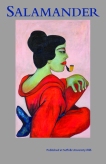Written by Nancer Ballard; ed. assistance by Savannah Jackson.
Barbara Leckie’s “Kicking the Stone,” in Salamander’s Summer 2018 issue, is a wonderful, complex short story that interleaves three life stories that broadly follow Victoria Schmidt’s formulation of the heroine journey. The short story revolves around the life trajectories of two sisters and a husband and the changing relationships between and among them.
In our lives we often complete the heroine’s journey cycle nonlinearly. We return to stages as new challenges are presented, and we examine previous experience more deeply. We can also work on several stages at one time. “Kicking the Stone,” illustrates the role that memories play in our navigating and narrating our lives, and flashbacks play in composing stories. Indeed, the “present” of the story takes place in the relatively static setting of a University town coffee shop in the space of about an hour. Flashbacks provide tension, action, context, emotional complexity, and pacing.
The story begins in a cozy coffee shop where Sylvia waits for her sister. It’s early spring, but a surprise snow storm has temporarily buried the crocuses. The setting suggests Victoria Schmidt’s heroine’s journey’s Stage one–the illusion of the “perfect” or “normal” progressing world, but almost immediately we realize that things are not what they seem because Sylvia is tearing tiny holes in numerous packages of sugar and pouring them into her tea to make a sugary slush at the bottom, as if her drink cannot be made sweet enough to swallow. She overhears a student at the next table say, “We are never quite prepared for death. I don’t think.” The overheard statement sounds unreal due to the lack of context and curious grammatical construction, but also ominous because it comes so soon in a composed short story.
Sylvia’s sister, Marg, arrives and apologizes for being late.  The author then describes Marg’s illusory perfect world from Sylvia’s point of view. Marg is a university professor who teaches in the linguistic department who “possessed the room” and commands “a sort of erotic attention [by] her confidence.” Sylvia, a couple of years older than Marg, feels as if she plays second fiddle to her younger sister. Sylvia has worked at a variety of community non-profits doling out food to the homeless and delivering community newspapers door-to-door. She is, by her own half-joking admission, “still trying to find herself.”
The author then describes Marg’s illusory perfect world from Sylvia’s point of view. Marg is a university professor who teaches in the linguistic department who “possessed the room” and commands “a sort of erotic attention [by] her confidence.” Sylvia, a couple of years older than Marg, feels as if she plays second fiddle to her younger sister. Sylvia has worked at a variety of community non-profits doling out food to the homeless and delivering community newspapers door-to-door. She is, by her own half-joking admission, “still trying to find herself.”
From this description of Marg as the “successful” sister and Sylvia as the plainer one who travels in her sister’s orbit, we are jolted by the matter-of-fact revelation that Sylvia is living, and has lived, with Marg’s husband for years. We are also told that Sylvia believes Marg had been negligent with her husband. The story thus abruptly enters the land of betrayal, or at least, coping strategies have not gone as expected.
We return to the present and Marg, the accomplished jilted sister, asks Sylvia if she is angry at her, again apologizes for being late, and asks if Sylvia has been waiting long—signaling that the story itself is moving on to Stage 3—Awakening and Preparing for the Journey. Sylvia reinforces this sense of anticipation by telling Marg that she has something to tell her without revealing what it is. Both sisters lean toward each other, signaling the importance of their relationship which the reader senses has been, and will be, its own journey.
The author again references Sylvia’s “affair” with Marg’s husband (the Stage 2 betrayal), and then a second blow up (Stage 6), before describing the period between the estrangements when the sisters reconciled and referred to Hugh, Marg’s former husband and Sylvia’s current partner as “our Hugh.” This moment feels like a Stage 5 “Eye of the Storm”– during which the sisters had managed to find equilibrium in their relationships with Hugh and each other.
We return to the coffee shop with Sylvia privately wishing she could begin the current conversation with something “as light and intimate and bonding” as an “our Hugh” reference– strongly suggesting that the story and the sister’s relationship and lives are headed for a Descent (Stage 4).
The story then takes one last backward glance at stage one’s illusory perfect world as Sylvia tries to find her footing before moving forward with the descent. She muses that she would have liked to open a similar coffee shop-bookstore, but the vision quickly fades. From here, the story continues to tack forward and back, like a carefully crafted multi-thread chain stitch that braids together the heroine’s journeys of the sisters and their relationship. We learn that Marg and Hugh were in a car accident years before that left Hugh in a wheelchair (his descent). Marg, who was pregnant at the time, appears to have recovered, but she has some irreparable nerve damage, and she lost her baby. Thus, we are introduced to Marg and Hugh’s experience of death (stage six) before we find out Sylvia’s news.
The semi-omniscient narrator describes the cause of the accident (a child’s game that ended in the street and an SUV rear-ending Marg’s and Hugh’s car); Marg’s rehabilitation and response to Hugh after the accident (the descent of their relationship); and Sylvia’s support of both of them. While Marg has largely blocked out the details of the accident and aftermath, Sylvia remembers them because “it had given her her life.” In this and in numerous other instances, Leckie uses a single sentence and moment to move characters into different stages of their journeys—in this case the Descent for Marg, and the Preparing for the Journey for Sylvia. 
The narrator continues to slice back and forth through Sylvia’s memory and narrative flashback, revealing the literal and psychological journeys of each of the characters as they move toward and away from their relationships with one another. With each move, Leckie illustrates the effect of a character’s action on the others and their relationships, which lead to new actions and effects that ripple throughout all the characters’ lives.
Back in the present, Sylvia reveals that the reason she has asked Marg to coffee is to tell her that Hugh (her partner now for at least a dozen years after the accident) has stage four colon cancer. We see a moment of shared concern for Hugh and for one another. Sylvia then refuses Marg’s request to go see Hugh immediately which we sense is, for Sylvia, a moment of truth and resolve (Stage 8) in the midst of her responding to others’ decisions and calamities. In this moment Sylvia is able to know and say what she needs—as hard-hearted as it seems at that moment of the story.
The story again flashes back to Sylvia’s support of Hugh and Marg after their accident, Marg’s growing impatience with Hugh, and Hugh’s attention to Sylvia in a way that makes her feel that she is more than Marg’s shadow. The story is constructed so that the reader is repeatedly surprised by the flashback action and then comes to understand and empathize with the character(s) and their journeys only to be surprised by another revelation—from Marg’s affair with a neighbor which launches Sylvia’s romantic relationship with Hugh, to Hugh’s confession to Sylvia that he and Marg have been once again sleeping together after Sylvia tells Marg that she is pregnant, etc. In each betrayal and struggle we wonder how things can be repaired after this move while hoping that somehow they can be, and knowing that somehow they must have been repaired, for now the sisters are sitting in a coffee shop talking honestly with each another and expressing concern for Hugh. There are no neatly tied-up endings in this story or in these lives, but there is beauty in the efforts each makes to live an authentic life and preserve difficult relationships that change in ways they do and don’t control under circumstances that are never ideal.
Back in the present, Sylvia has still not agreed to a specific time when Marg can come visit Hugh, but Marg has stopped pressing, and the story and the sisters know that it will not be long.  Marg listens to Sylvia describe Hugh’s illness and the difficulty of telling Sylvia’s kids (she now has two) and tears up when Sylvia tells her she already finding feels sad to see High’s empty coat hanging in the hall.
Marg listens to Sylvia describe Hugh’s illness and the difficulty of telling Sylvia’s kids (she now has two) and tears up when Sylvia tells her she already finding feels sad to see High’s empty coat hanging in the hall.
Nothing is simple for these characters, but there is an underlying conviction that they will do whatever it takes to affirm their important relationships and themselves, although they don’t yet know how this will happen. In the last paragraph of the story, after Marg has left the coffee shop and Sylvia is preparing to leave, Sylvia remembers Marg telling her the last last thought she had before the SUV slammed their car into the car ahead in the accident that altered the course of all of their lives. “Brace Yourself” is both a warning and a strangely affirming declaration that the task of life, regardless of our current situations, is to engage reality while acknowledging and aligning ourselves as best we can with internal truths.

“Kicking the Stone” can be found in the summer 2018 issue of Salamander. Salamander is one thirty-plus literary journals offered by the Journal of the Month Club that enables you to sample a variety of literary journals for the price of one or two. Click here to see their holiday specials.


I love this. Thanks for the deeper look at this beautiful story. How does the title tie in?
LikeLike
In 1763 Bishop Berkeley and Samuel Johnson were walking in the English countryside and arguing about the nature of reality. Berkeley claimed that nothing in life is material or real; it is all a construction of your mind. Johnson is said to have kicked a large boulder beside the path so that his foot bounced off the stone and said, “I refute it thus.” Thus “Kicking the Stone” can mean that reality is its own proof and doesn’t require complex reasoning, or it can mean that saying something is true with enough force will function as proof even if there is no logic behind it. These apparently opposite interpretations are also similar to the role that the heroine’s and hero’s journey play in stories and lives. On the one hand the heroine’s journey which values life cycles, inclusiveness, and cooperation is felt to be intuitively consistent with what we know about the ecology of the world, and therefore, “real,” while others would argue that the hero’s journey values of competition, tribal loyalty, and “survival of the fittest” governs the real world. In the story, there is another reference to kicking an object—the car accident that destabilizes Marg’s and Hugh’s marriage and is a precipitating factor in Sylvia and Hugh’s relationship is caused when children playing “kick the can” boot the can into the street and cause a three-car accident. This too works as a confounding reference. Kick the can is played like tag, and if a hider is able to elude the seeker and “kick the can” he is “home free,” and in some versions of the game automatically frees whoever else has been previously caught. Obviously, the car accident was anything but a “home free” for the pregnant Marg and Hugh, but it did set in motion the home that Sylvia would eventually find. I’m not sure if either of these interpretations was what the author, Barbara Leckie, had in mind— for that I will “kick the can down the road” (another version of the metaphor that normally means to put off a final decision) to her if she cares to weigh in.
LikeLike
I’m sorry for my delay in replying! Nancer does a lovely job elaborating on the title above. I was also thinking about the way that the stone anecdote raises the question of _how_ we know what is real. And it raises it as an unresolvable question (even if these particular interlocuters think they have solved the problem). Perhaps “kicking the stone” keeps that conversation alive, and unresolved, in exactly the way that Nancer refers to in her closing comment.
LikeLike